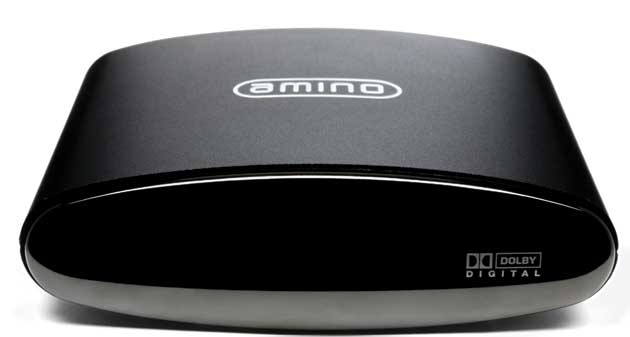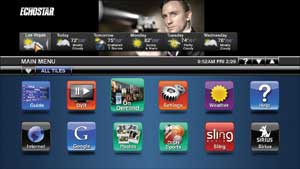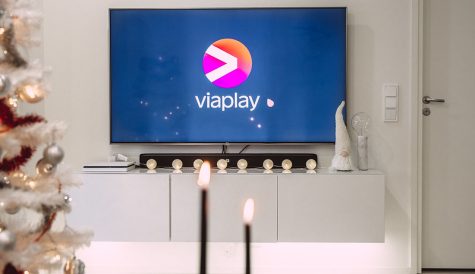
After more than 40 years of operation, DTVE is closing its doors and our website will no longer be updated daily. Thank you for all of your support.
Set-top solutions
Set-top box vendors must be ready to serve operators of all shapes and sizes with a range of business models.
Set-top box vendors, like other technology providers in the IPTV space, are caught at a cross roads. On the one hand, new IPTV services continue to launch with very basic features, while on the other, some operators are looking to offer advanced features, from multiroom to HD, DVR to internet applications. Flexibility is key, says Amino’s (IBC 5.B40) product marketing manager David Groves. “There are still a large number of new deployments where the service provider is simply having to deal with all the issues that faced now-established services that rolled out a few years ago, such as competing with other delivery mechanisms. In other parts of the world, with established services, building on the existing deployment, offering a compelling service to include catch-up, OTT and video-store applications is a new challenge.”
For Romain Waller, general manager of Thomson’s (IBC 1.E02) set-top boxes unit, operators want to deliver a seamless experience across various services, including internet functionality and video-on-demand as well as linear TV channels. “This will drive up subscriber numbers, which means that that operators will have to search for solutions that increase reach, such as hybrid IPTV, quality of service and open internet delivery,” he says.
 Thomson is currently investing in a new generation of platforms that are more powerful than previous versions to enable operators to deliver these kinds of services. “Our software development is focussed around bringing more revenue-generating functionality, which keeps users in the IPTV environment longer,” says Waller. “The need for hybrid systems, which link IPTV and conventional broadcast, is a top priority which impacts every part of our offering: set-top boxes, gateways and service platforms.” Waller also highlights the importance the move to MPEG-4 decoding has played in IPTV delivery: “H.264 is now proven and in widespread use, delivering bitrate savings of 50% or more over MPEG-2.” He says it has also opened up the practicality of HD over IPTV. However, he says, delivering reliable IPTV to the greatest number of eligible subscribers is now achieved through a range of different solutions, apart from simply increasing the line speed: “Quality of service features over IP can be implemented, such as forward error correction and real-time packet retry. Subscribers with relatively slow circuits can also still enjoy VOD thanks to adaptive streaming or progressive downloads.
Thomson is currently investing in a new generation of platforms that are more powerful than previous versions to enable operators to deliver these kinds of services. “Our software development is focussed around bringing more revenue-generating functionality, which keeps users in the IPTV environment longer,” says Waller. “The need for hybrid systems, which link IPTV and conventional broadcast, is a top priority which impacts every part of our offering: set-top boxes, gateways and service platforms.” Waller also highlights the importance the move to MPEG-4 decoding has played in IPTV delivery: “H.264 is now proven and in widespread use, delivering bitrate savings of 50% or more over MPEG-2.” He says it has also opened up the practicality of HD over IPTV. However, he says, delivering reliable IPTV to the greatest number of eligible subscribers is now achieved through a range of different solutions, apart from simply increasing the line speed: “Quality of service features over IP can be implemented, such as forward error correction and real-time packet retry. Subscribers with relatively slow circuits can also still enjoy VOD thanks to adaptive streaming or progressive downloads.
Hybrid models
Set-top box vendors are keenly aware of the need to develop IPTV boxes with the ability to receive DVB broadcast content. Pace’s (IBC 1.B19) general account director of telecoms Frederic Maizeret describes hybrid set-top boxes as a “market need” as operators look to mange the delivery of linear content via DTT, cable or satellite and selected content and services via IP. “There is currently a very high demand for hybrid IP solutions,” he says. “The hybrid model both reduces network strain and offers the benefits of an IP-based two-way path, which is something that has been absent from much of the TV landscape until now.” Another reason, he points out, is that it is not possible in some cases to reach all customers with ADSL, paving the way for a hybrid solution to provide connectivity. “The net result is that IP is becoming an integral part of the redefined pay-TV experience, regardless of which service subscribers sign up to,” he says.
“There is currently a very high demand for hybrid IP solutions.”
Frederic Maizeret, Pace
Amino’s Groves agrees that it’s important to distinguish between the different flavours of hybrid. “An IP-centric set-top box that also receives and decodes broadcast content, but controlled entirely through the IP middleware, is a different proposition to a broadcast-centric set-top utilising a standard DVB-T stack, that has an additional IP connection for OTT, premium or paid content,” he says, adding that both scenarios are being requested. “The provision of catch-up services by broadcasters is driving high interest in hybrid solutions offering in effect a two-way EPG,” he says.
EchoStar Europe (IBC 4.B54) will be demonstrating a number of hybrid solutions at IBC, including the new HDX-600 series digital video DVR. Demand for hybrid services remains high, particularly in the EMEA region, according to Ian Walker, sales and marketing director at EchoStar Europe. He says that those countries that have been able to sustain the levels of investment in infrastructure necessary to provide high bandwidth services are able to offer feature-rich IPTV including multi-channel linear TV. “For those who do not have adequate bandwidth and data rates – a sizeable minority at least – using conventional broadcast for linear programmed TV considerably reduces loading on the network allowing optimum bandwidth utilisation for premium and on-demand pay services,” he says. “For multinational MSOs it is also possible to achieve coherent branding by offering a minimum level of services across all operations and utilising hybrid where there is low bandwidth.”
ADB (IBC 5.B48) was the first set-top box company to be certified to use the new DLNA (Digital Living Network Alliance) home networking standards. As far as the company is concerned, the best approach to developing hybrid solutions is to deploy proprietary implementations of open standards. “Using open standards, such as DLNA, is the best way of guaranteeing interoperability and ensuring the industry remains dynamic, with devices being able to interact with one another,” he says. “Using a proprietary implementation ensures that all elements are fine-tuned for optimal performance.”
Pirelli Broadcasting Solutions’ (IBC 5.A35) director of marketing and innovation Roberto Pellegrini is also preparing for a hybrid future: “We expect demand for hybrid to increase over time as a natural response to multi-source content offerings for consumer and as the result of evolving business models by traditional broadcast players.” At IBC, Pirelli will showcase a new range of HD H.264 hybrid set-tops, the HY2000. Based on a core IPTV product, satellite, DTT and cable interfaces can be added as modular interfaces, says Pellegrini.
Multiroom services
While operators are looking at hybrid to deliver content more efficiently, some are also developing ways to move content around the home. Multiroom can be used to increase ARPU or prevent churn, and set-top vendors are playing an important role in the process. “Customers want the convenience of having their content with them at all times. Content providers want the cost savings,” says an ADB spokesperson. In the majority of cases, the DVR plays the central role in a multiroom scenario. ADB’s solution consists of a multiroom DVR with tuner sharing applications. “Having a DVR that can be shared rather then having multiple DVRs in the home can save everyone money,” the spokesperson says.
Multiroom is also a key area for Pace and it is developing a range of solutions, including a multiroom DVR with a 300GB hard drive that can be accessed by connected set-top boxes in the home, providing DVR functionality for each user. One customer, France’s Canal Plus, has introduced streaming of live TV from one set-top to another over a network. The Plus Le Cube DVR has two tuners – one to play or record TV for the primary TV, and the second to enable a separate stream via Ethernet to another set-top in the home.
According to EchoStar’s Walker, best-of-breed practices will begin to emerge from the various solutions available at the moment. “There are sufficient flavours and participants to allow best-of breed to emerge in due course. Sufficient standardisation activity is already in place (e.g. DLNA) to provide a good starting point for this nascent technology. The technology is certainly ready to meet market requirements as they emerge.”
 Those “flavours” are varied. Amino’s Groves is seeing active requests for varying levels of home connectivity. For instance, he says, middleware providers can deliver enhanced multi-room features such as the central DVR accessible from other non-DVR set-tops, through to standards-based features such as UPnP and DLNA, offering inter-connectivity between the STB and other products such as PCs, games consoles or mobile devices. “In the latter case, content that is stored on other devices, or is entering the house by an alternative route, still needs to find its way to the set-top for living-room viewing in a simple and user friendly way,” he says. “In parallel, the associated technologies of moving video content around the home, such as power-line, wireless or coax, are now becoming viable.”
Those “flavours” are varied. Amino’s Groves is seeing active requests for varying levels of home connectivity. For instance, he says, middleware providers can deliver enhanced multi-room features such as the central DVR accessible from other non-DVR set-tops, through to standards-based features such as UPnP and DLNA, offering inter-connectivity between the STB and other products such as PCs, games consoles or mobile devices. “In the latter case, content that is stored on other devices, or is entering the house by an alternative route, still needs to find its way to the set-top for living-room viewing in a simple and user friendly way,” he says. “In parallel, the associated technologies of moving video content around the home, such as power-line, wireless or coax, are now becoming viable.”
Thomson’s Waller agrees that a standards-based approach to multi-room across hardware and software platforms will play an important role. “There is no doubt that consumers want to be able to access content wherever they are, on whatever device is most convenient at the time,” Waller says. “Home networking is now commonplace, and as an industry we now need to add the hardware and software layers that make exchanging rich content practical. WiFi and MoCa provide the transport layer, and we see DLNA as the best solution to achieve open interoperability between diverse devices.”
Pirelli anticipates that home networking and multi-room connectivity will play a major role in service providers’ offerings going forward, according to Pellegrini. He says the company has been a pioneer in specialised wireless video distibution in the home. “We expect to see the demand for this to increase as the bar for quality and reliability is raised by the launch of H.264 HD content,” he says. “We now offer wireless HDTV, not only as a multi-vendor solution via external dongle adapters, but also as an embedded option in our latest set-top boxes and home gateway products.”
One company taking a different approach to multiroom is EchoStar. The company owns place-shifting technology company Sling Media, best known for its Slingbox that allows consumers to watch content from a TV on a PC anywhere in the world with an internet connection. More recently, it released SlingCatcher, software that uses the same technology to deliver content to any TV. In January, EchoStar announced the launch of the world’s first place-shifting high definition DVR, which incorporates Sling Media’s technology – the EchoStar SlingLoaded 922. “At IBC, we will showcase a comprehensive home networking and place-shifting ecosystem that will enable customers to Sling content from their living room to other devices including laptop, mobile phone or second TV,” says Walker.
One school of thought says that the DVR will become the gateway device, capable of receiving content to the home and delivering to devices around the home. “We get a lot of questions about who will own the home,” says ADB. This question is based on the assumption that internet/TV convergence is about technology, about providing the consumer the ultimate “tool” that will control everything for him. “On the contrary,” says ADB. ”We believe that Internet/TV convergence is about content – about enabling the consumer to enjoy the content he wants, whenever, wherever and on whatever device he wants it. So our work is focused on helping the content move seamlessly across the home, not on trying to control the way the consumer wants to access content. Ultimately, it’s the consumer who owns the home.”
Echostar Europe’s director of marketing and communications, Mark Goodburn, says that the home gateway is likely to become increasingly important. “There seems to be some questions to be answered around Quality of Service and the commercial proposition beyond provision of the gateway itself,” he says. “However, we can probably expect to see its continued development and increased prominence in the medium term.” Amino’s Groves takes a more cautious approach. “For IP services, the development into a home gateway can seem logical from certain technology angles, but there are a number of issues that question the practicality of this,” he says. “The telecom termination is rarely in the vicinity of the TV, for example. Also, the DSL modem/router is a low-cost, retail device that does end up being replaced due to product failure more often than other devices.” He suggests cable based home-gateways could lend themselves more favourably to such an application.


